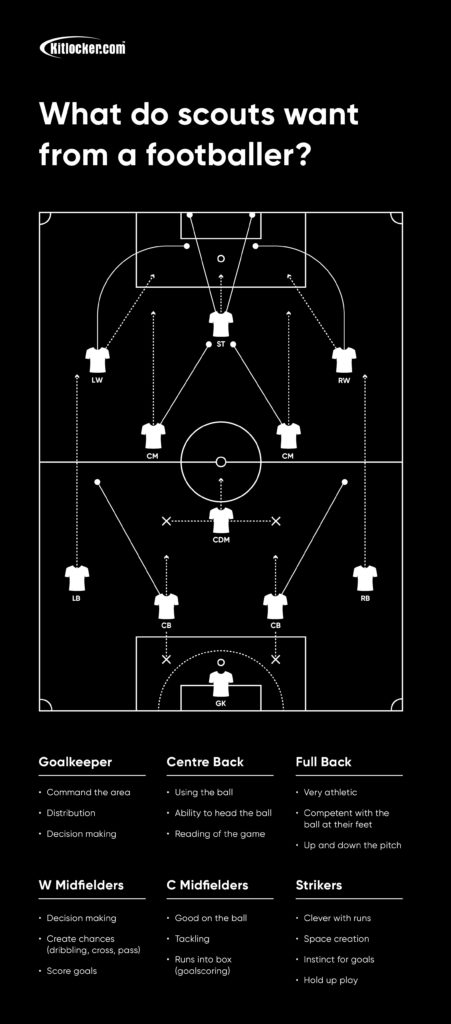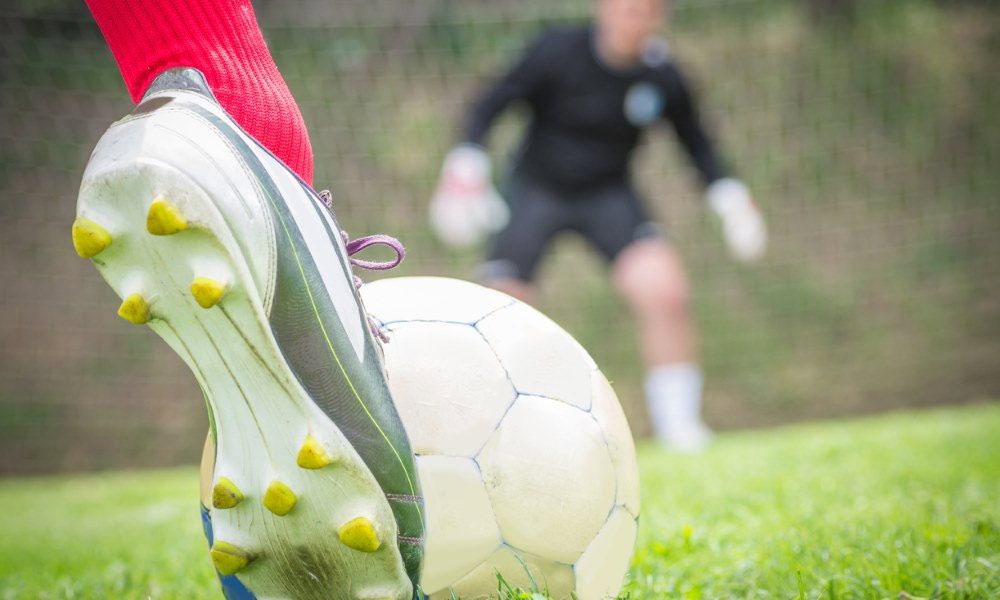Each and every weekend, on rainy pitches across the country, you can guarantee that at least one player in every team is wondering if today is the day that they will get their ‘Jamie Vardy’ moment.
It’s not unheard of for players to be scouted from grassroots level, as Vardy’s experience goes to show, so in the event that a scout did rock up, what would they be looking for?

To determine exactly what top scouts are looking for, we spoke to two of the best in the business:
Tim Coe, Chief Scout at Crystal Palace is experienced in spotting the potential in young players as Palace have famously brought Nathaniel Clyne, Wilfred Zaha, Wayne Routledge and Victor Moses through their academy.
Joel Purkiss, scout at Revo Sports Management works with teams across the league and is no stranger to finding players at grassroots level. Most recently, Joel has been scouting for Sheffield United’s U13 youth team.
KITLOCKER
What are the key characteristics that you would look for in a player from the grassroots/amateur leagues across the different positions?
Goalkeeper
TIM: We assess each player on four ‘position specific’ components, each comprising of defending and attacking aspects. In a goalkeeper we would look for handling and shot stopping, command of the area, coming from the line and distribution.
JOEL: At an amateur level, the first thing you’re looking for is how a player reads the game, how they command the area and their kicking, as well as their decision making. Decision making as a goalkeeper is crucial because in lots of situations, it’s the difference between not conceding and letting a goal in.
Full Back
JOEL: Full Backs are almost like extra attackers now, especially when deployed in the 352 formation that we’re seeing sweep across the Premier League. Full backs now are typically very athletic and competent with the ball at their feet and are expected to get up and down the pitch as quickly as possible.
Centre Back
JOEL: The two components I look for in a centre back is their ability to head the ball and their reading of the game. The centre back needs to understand situations when they should be going into a tackle to win the ball back and when they need to drop off, covering a team mate. More and more centre backs are now encouraged to be confident with the ball at their feet, moving away from the ‘Kick it, Head It’ mentality that has dominated lower leagues.
TIM: For a centre back we would look for defending against direct play, defending up the pitch, defending in the defensive third and using the ball and attacking set pieces.
Wide Midfielders
JOEL: Here we are looking for players whose first thought is to get forward. To attack and create chances for the forwards, as well as contributing goals themselves. Decision making is also a key aspect, when to cross, when to pass and when to dribble.
Centre midfielders
JOEL: In a central midfielder, coaches are looking for the whole package. Are they good on the ball? Can they tackle? Can they get into the box and score a goal? Can they provide for the rest of the team?
Strikers
JOEL: Strikers are judged on one thing: goals. What can they produce in the opponent’s box? Are they clever with their runs? Do they create space for themselves and others? Strikers should be natural in front of goal, they shouldn’t have to look at the target to know where it is. Having the ability to do this saves them vital seconds as a defender looks to take the ball away from them. We’re also looking for a striker to hold up the ball, depending on the team’s style of
play. Can they hold off defenders before finding a winger in space?

KITLOCKER
Do scouts acknowledge that certain areas may need refining and perhaps need further training?
TIM: Every player will have relative strengths and weaknesses in their position. Their suitability or otherwise to us will be determined by what we are looking for in that position which is determined by the philosophy set by the club and/or by the manager and the needs of the team at that particular time.
If we are looking to defend deep than we will need centre backs who are good defending against direct play and defending in the defensive third, but we may be able to compromise on their defending up the pitch. Some areas of a player’s performance can be improved further than others. For example, a centre back’s positioning, reading of the game and decision making can improve significantly with a good development program, plus a good mentality from the player. Other psychological and technical elements are harder to make significant strides in.
JOEL answered according to position:
Goalkeepers
I’ve seen goalkeepers who have improved dramatically from specialised training, across multiple areas such as positioning, shot stopping & handling. We’ll look for goalkeepers that can demonstrate the mental skills such as decision making over their ability to save a shot because that technical side of the game is easier to develop with specific training drills.
Full Backs
Full backs are put on specific training drills to improve the timing of their runs to assist with attackers scoring a goal, whether it be via a cross or dragging a defender towards them by making an off the ball run.
Centre Backs
If a player excels with the ball at their feet, the tackling and heading aspects can be worked on in training.
Wide Midfielders
Correct coaching can see decision making increase.

KITLOCKER
Do you look for different things across the different levels?
TIM: Watching prospective transfer targets is more of a prediction than an assessment because you can see what they are doing in their team now but you need to know what they can do in our team in the future, and watching prospective development players involves even more of a prediction. Important factors to consider here are character and personality and potential for future growth.
JOEL: As top level scouting shifts towards technically competent players that demonstrate an understanding for their position, this will filter down the leagues which will see more of these players picked up from amateur clubs.
KITLOCKER
What emphasis do you put on scouting grassroots football? Is there any value scouting down the leagues?
JOEL: Scouting at a grassroots level is very important, there are so many players that are good enough to compete in professional leagues but for whatever reason haven’t been picked up or they may have been dropped by an academy or simply didn’t get the chance. More and more players are being signed from non-league football teams and a lot of this is down to the success of Jamie Vardy and teams realising that there is a lot of talent that isn’t involved in a professional club. Whilst the player might improve the team, their value will also skyrocket, another important aspect for lots of clubs who rely on player sales to continue running.
TIM: We spend the vast majority of our time watching lower league and non-league football. There is a lot of talent and potential and there are a lot of examples of players who have risen through the levels to play at the highest level. It is much more difficult to go through the levels in one jump. It’s more common to take two or more steps. But we are always looking for the exception.

Maybe, just maybe…
The good news for amateur teams is that there is every chance of being spotted at grassroots level. Taking Tim and Joel’s advice on board and considering how you can apply it to your own game may help you tailor your performance, physically and mentally, to suit the attributes that are currently desirable to premier league clubs.
There is no denying that the challenges presented through grassroots football can sometimes feel quite demoralising for players, making it difficult to ever imagine that there may be life beyond Sunday league. However, as Tim suggests, personality and character play a huge part in deciding whether a player is worth watching.
No matter how small or low in the league your club may be, the star players are those who display pride in pulling on their club strip and stepping out onto the pitch as a united team, and giving their all regardless of the conditions. Attitude and team unity goes a long way towards raising a player’s desirability, and just as the old cliché ‘there is no I in team’, suggests, no one is ever looking for individual stand-alone players.
So, when the last thing you feel like doing after a busy week in the office or at school is dragging yourself along to a drizzly football pitch, just remember, you never know who is watching.
How useful was this post?
Average rating 1.8 / 5. Vote count: 9
No votes so far! Be the first to rate this post.
